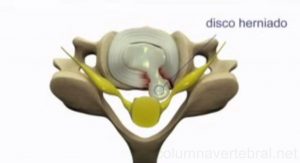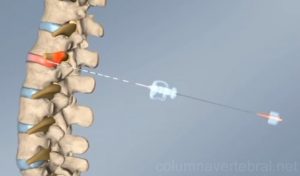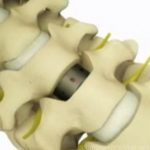 La discectomíto the disketteía is a type of surgeryíWhat is removal looking for?ón total or partial of one herniated disc. Ésta oppresses to the raíz of a nerve or that exerts pressureón on the méspinal game.
La discectomíto the disketteía is a type of surgeryíWhat is removal looking for?ón total or partial of one herniated disc. Ésta oppresses to the raíz of a nerve or that exerts pressureón on the méspinal game.
The intervertebral disc is each pad that lies between the vévertebrae of the spine. ÉThese are responsible for its cushioning.ón. This cartilaginous structure actsúlike a ligament whose functionón is to keep the véunited vertebrae and allow mobility to the spine.
When a displacement of that n occursúcleo pulpy (pertaining to the intervertebral disc towards the raíz nervous), herniated disc occurs. In this case beá need a discectomyía to release this presiówhat is caused.
Index
Microdiscectomía
the surgeryía spine by microdiscectomyíto the microdecompressionón is a témodern technique that is performed to eradicate disc hernias. Disc material is removedñby means of a smallña pearlóno greater than 4cm. This cut will be madeá where the affected intervertebral disc has previously been located. When visualizing the raíz of the affected nerve, proceedá to your decompressionón.
About the raíNervous breaks you caná observe a yellowish membrane, which to beá removed. This procedure may not be enough to reach the raíz and have to remove a smallñfracción of the jointón bottom so release presiónot about the same.
at the discectomyíthe conventional, this incisionón is one sizeñor a little older, so it does not require vision amplifiersón.
Discectomía lumbar
 La discectomílumbar is an interventionón wantúsurgery to remove a herniated disc that has formed in the lower back, precisely in the lumbar area.
La discectomílumbar is an interventionón wantúsurgery to remove a herniated disc that has formed in the lower back, precisely in the lumbar area.
It is usually performed by a microdiscectomyía, with the help of a special microscope to clearly see the intervertebral disc and nerves.
There is a new tétechnique that has developed basedástanding on this principle, that it's called discectomía Lumbar Percutánea Endoscópica, which consists of removing the herniated disc accompaniedñI'm in a diséctome and a laser probe. The herniated material is removed by suction.ón and is reduced with the laser probe, for a decompressionón successful. The surgeon will guideá during the procedure with radiographyíthe successive.
Discectomía cervical
La discectomía cervical, seeks to eliminate a herniated disc that is located in the cervical area. To treat these cervical hernias, different t have been developedétechniques.
Discectomía cervical posterior. This técynic develops by vía posterior, from the back. The surgeon beginá making a littleña pearlón. Éstay see haveá on the front of the neck, in the positionón más close to the affected disc. Then move the múmuscles so that the spine can be reached without hindranceáglasses. Hereí mayá directly appreciate the disk givesñado.
Special care should be taken with this tétechnique. In the area there are numerous veins that can cause abundant bleeding and limit visualization.ón at the time of the interventionón.
Discectomíto anterior cervical with intersom arthrodesisática. it's a tétechnique that is applied to correct worn or damaged discsñok. It consists of removing the intervertebral disc and replacing it with a graft. óseo, with this it is possible to decompress the raíz nerve and relieve pain. this graft óseo should mimic the functionón of the original intervertebral disc.
Discectomíto anterior cervical and fusión. it's a tétechnique very similar to the previous one. Sówhat hereí removing the disk merges the space. A plate is placed in the frontal sector of the graft to give greater stability. The procedure is performed by applying a smallña pearlón on the front of the neck and throughés from this the disk is extracted.
Discectomía percutáne with ozone
It consists of the introductionón a needle, which is inserted directly into the affected intervertebral disc containing the herniated disc, low visión fluoroscopica (X-rays). Through this needle we are able to make a nucleotomyía percutánea.
The nucleotomía percutánea is a new técnica míminimally invasive, that eliminates herniated discs without the need for surgeryíto open. It's an interventionóno ambulatory.
By removing part of theúpulpy cleo decompression is guaranteedón on the méspinal cord or raíaffected nerve z.
La discectomía percutáline with ozone uses an instrument called “disc dekompressor”. ÉThis provides an effective treatment to cure the protrusions, contained bulging and herniated discs. The méall is 90% effective in treated patients.
La tétechnique used is ambulatory and recoveryóno immediate. The estimated time in the interventionón is from 15 a 30 minutes, with local anesthesia. cataloged from míinvasion nameón, with little affectationón about the structures of the annulus fibrosus and the intervertebral disc.
Postoperative of a discectomyía
 Once the intervention is overón wantúrgica, the patient can turn and look for the positionón más cófashion in bed. Past 24 hours laterés the patient can get out of bed and take a few steps with help and supervisionóin the métreating doctor.
Once the intervention is overón wantúrgica, the patient can turn and look for the positionón más cófashion in bed. Past 24 hours laterés the patient can get out of bed and take a few steps with help and supervisionóin the métreating doctor.
afterés of a discectomyíWith cervical pain, you may wake up with a sore throat and have trouble swallowing food for a few days.ías.
Depending on the evolutionón and the severity of the surgeryía, the patient beá discharged within the first 4 días (and discectomyía es cervical, the recoveryón is más ráask).
In the first weeks the méI say recommendá walk daily and use a lumbar belt during that time (órtesis). Well, rehabilitation is ruled outóno at that time.
The stitches are removed between the 12 and 15 días, but the patient must continue in rehabilitationón.
If the doctor approves, the patient caná return to work between 1 and 3 months (depending on the type and working conditions).
